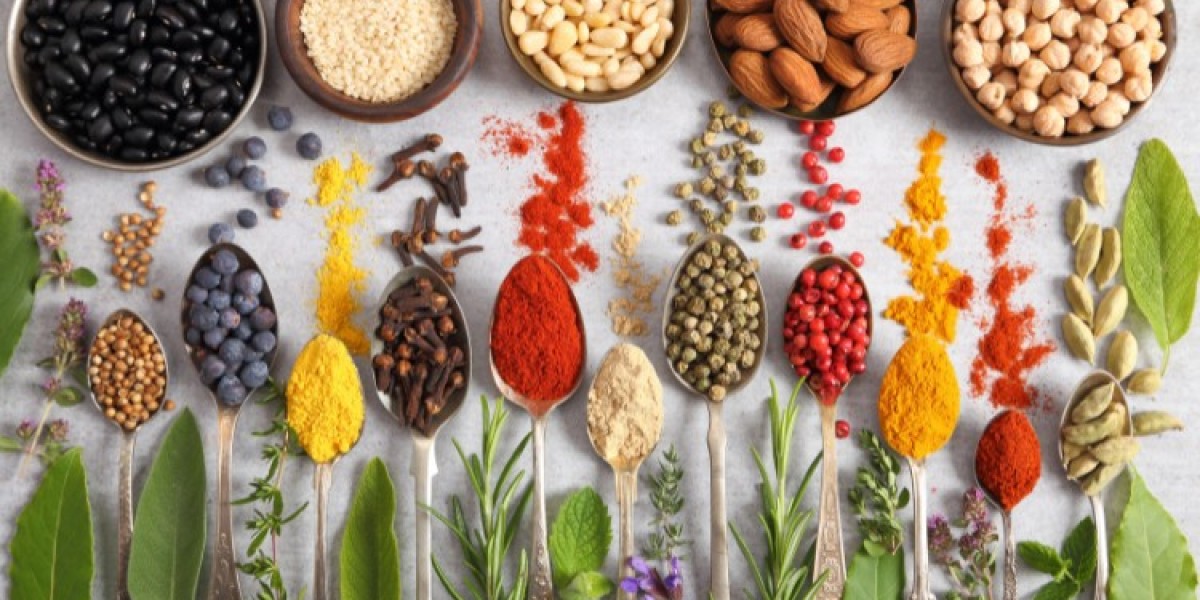The global spices and seasonings market achieved a significant milestone in 2023, reaching a value exceeding USD 27.93 billion. Forecasts suggest that this market will continue to flourish, growing at a compound annual growth rate (CAGR) of 5.6% from 2024 to 2032, and is expected to reach USD 45.61 billion by 2032. This substantial growth highlights the increasing global demand for these essential culinary ingredients.
Spices and Seasonings Market Outlook
India has firmly established itself as the world's largest exporter of spices, with exports valued at USD 3.89 billion in 2023. Following India, Turkey emerged as the eighth-largest exporter, contributing USD 294.72 million in the same year. India's spice production witnessed remarkable growth, increasing from 67.64 lakh tonnes in 2015 to 106.79 lakh tonnes in 2021, at an annual growth rate of 7.9%. Notably, spices such as garlic (14.7%), ginger (7.5%), fennel (6.8%), coriander (6.2%), fenugreek (5.8%), red chilies (4.2%), and turmeric (1.3%) saw significant production growth in 2021.
Market Growth Drivers
Spices and seasonings are aromatic flavoring agents derived from various parts of plants, including seeds, bark, rhizomes, and fruits. They are used in cooking to impart desired flavors to dishes. Several factors are driving the growth of the spices and seasonings market:
- Rising Global Population and Income Levels: Increasing population and higher income levels are boosting the demand for food, and consequently, for spices and seasonings.
- Popularity of Ethnic Cuisines: The growing interest in ethnic cuisines and new food experiences is opening new opportunities for manufacturers.
- Nutritional Awareness: Increasing awareness about the nutritional benefits of spices and herbs is propelling their demand.
- Pandemic Impact: The demand for healthy spices like turmeric, ginger, and garlic surged during the pandemic, driving market growth.
- Herbal Drinks Trend: The rising popularity of herbal drinks is also contributing to the market's expansion.
Key Trends and Developments
Several key trends and developments are shaping the spices and seasonings market:
- Ready-to-Eat Foods: The growing demand for ready-to-eat foods is driving the consumption of spices and seasonings.
- Ethnic Cuisines: Increasing popularity of ethnic cuisines such as Thai, Indian, Chinese, and Vietnamese is boosting the market.
- Health Benefits Awareness: Consumers are increasingly seeking healthier food options, leading to a growing demand for organic and functional spices.
- Technological Advancements: Manufacturers are adopting advanced technologies like encapsulation to extend the shelf life of spices and maintain their freshness.
Recent Developments
- June 2024: The Department of Science and Technology's Industrial Technology Development Institute (DOST-ITDI) developed garlic, onion, chili, and herb-flavored salt and seasoning products to boost the Philippines' salt industry.
- June 2024: QatarEnergy announced plans to build a QR1 billion industrial and table salt production plant in Um Al Houl through a joint venture with Mesaieed Petrochemical Holding Company (MPHC) and Qatar Industrial Manufacturing Co. (QIMC).
- June 2024: The Indian Council of Medical Research (ICMR) advised consumers to prefer whole spices over powdered ones to mitigate the risk of adulteration following reports of adulteration in popular spice mixes.
Segmentation Analysis
The market is segmented based on type, form, application, distribution channel, and region.
By Type:
- Spices: Pepper, ginger, cinnamon, cumin, turmeric, coriander, cardamom, cloves, and others.
- Herbs: Garlic, oregano, mint, parsley, rosemary, fennel, and others.
- Salts and Salt Substitutes
By Form:
- Whole
- Crushed
- Powder
By Application:
- Bakery and Confectionery
- Meat and Poultry
- Snacks and Convenience Foods
- Soups, Sauces, and Dressings
- Beverages
- Frozen Products
- Others
By Distribution Channel:
- Offline
- Online
By Region:
- North America
- Europe
- Asia Pacific
- Latin America
- Middle East and Africa
Market Share and Segment Insights
Spices dominate the market due to their extensive use in various cuisines and their associated nutritional benefits. Common spices include pepper, cardamom, cinnamon, clove, nutmeg, and turmeric, widely used in Indian, Middle Eastern, and Asian dishes.
Herbs like thyme, basil, oregano, and parsley are also significant, driven by their use in Mediterranean, Italian, and Middle Eastern dishes. The demand for herbs is fueled by the popularity of international dishes such as pizza and pasta.
Salt and Salt Substitutes enhance the taste of food, with salt substitutes reducing sodium content in dishes. Products include table salt, sea salt, Himalayan pink salt, and salt-free seasoning blends. The demand for salt substitutes is driven by growing awareness of the health effects of excessive sodium consumption.
Powdered Spices hold the largest market share due to their ease of use and wide availability. The demand for powdered spices is increasing due to consumers' preference for flavored and spicy foods.
Whole Spices are expected to grow rapidly, providing a more authentic flavor to dishes. Rising concerns about adulteration in powdered spices may also drive the demand for whole spices.
Crushed Spices add texture and aroma to dishes and include products like crushed black pepper, red pepper, and garlic.
Leading Manufacturers
Key market players are leveraging technology and digital marketing to reach more consumers and build brand loyalty:
- McCormick & Company, Incorporated: A leading manufacturer and distributor of spices and extracts, McCormick operates in over 170 countries. Founded in 1889, it is based in Maryland, USA.
- Olam International Limited: Based in Marina South, Singapore, Olam operates in over 60 countries, supplying food ingredients, industrial raw materials, feed, and fiber. It was founded in 1989.
- Ajinomoto Co., Inc.: Headquartered in Tokyo, Japan, Ajinomoto offers seasonings, food flavors, processed foods, sports nutrition, animal nutrition, coffee products, powder beverages, frozen foods, and sweeteners. The company was founded in 1917.
- Kerry Group plc: Based in Tralee, Ireland, Kerry Group provides taste and nutrition solutions for food, beverage, and pharmaceutical markets in over 80 countries. It was founded in 1972.
Other notable players include SHS Group.
Regional Analysis
Asia Pacific and North America are the largest markets for spices and seasonings. The Asia Pacific region, particularly India, Vietnam, China, and Thailand, leads in production and export. India alone exported 15,39,692 tonnes of spices valued at USD 4,464.17 million in 2023.
North America is a significant market, with the United States being a key contributor. The region's growth is driven by the demand for convenience foods and the popularity of ethnic cuisines. In 2021, McCormick & Company was the top supplier in the US food sector, with the growing retail sector also supporting market growth.
The global spices and seasonings market is poised for substantial growth in the coming years, driven by factors such as rising global population, increasing income levels, and the popularity of ethnic cuisines. The market's segmentation across types, forms, applications, and regions provides a comprehensive understanding of the diverse factors influencing its growth. Leading manufacturers are leveraging technology and digital strategies to expand their reach and maintain market dominance. As consumer preferences evolve towards healthier and more flavorful food options, the spices and seasonings market will continue to thrive.



